This section is relatively short because .... well, .. we really don't know very much about the giant, gaseous planets that inhabit the outer regions of our solar system. The probes and orbiters we sent to these worlds have sent back volumes of data which only tend to raise more questions than provide concrete answers.
Relative sizes of the Jovian planets
As stated in the introduction, all the Jovian planet have rings (Saturn being the most pronounced) and each planet has a family of moons. We know the rings are composed of much smaller ice particles whirling around these planets, some as small as the size of dust. Astronomers have often wondered how these two features are related. For example, are the rings a permanent feature on each planet? Did the moons form from the rings? Do incoming asteroids and comets, on occasion, smash into a moon, ... blasting it into smaller pieces which later becomes raw material for the rings? Did a comet get too close to the planet, and the tidal forces pulled it to pieces, ... providing raw material for making rings? Lots of questions, ... no definitive answers!
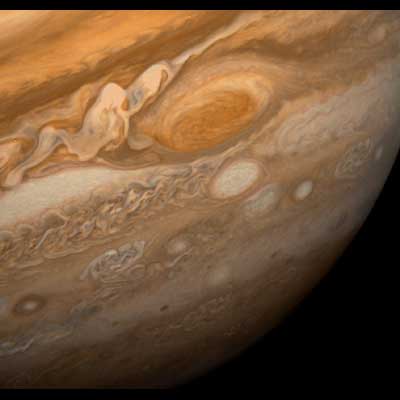
Credit NASA
Jupiter is, by far, the most massive of all the planets (and it is the largest). It has a mass 318 times that of Earth. It has (like all the Jovian planets), a low density. The reason comes from the fact that it is composed of lighter gasses which are very similar to the composition of the sun, 90% hydrogen and 10% helium (at least at the "surface"). Why the quotes? Because Jupiter shows no solid surface (although astronomers believe a solid body exists deep below the gasses). When we look at Jupiter, we see a chaotic, swirling, turbulent, thick atmosphere. Jupiter is mainly a giant gas planet. The pressure of this hydrogen gas becomes so high as you move down through the atmosphere that it behaves more like a liquid than a gas, so maybe we should call Jupiter a liquid hydrogen planet.
Jupiter has a very strong magnetic field (20,000 times stronger than the earth's magnetic field). This suggests that Jupiter has a fairly active interior. Perhaps the swirling liquid hydrogen acts as a huge dynamo to create this effect. Jupiter also radiates much more energy into space than it receives from the sun. This excess energy may come from one or all of the suggestions below:
heat released by the radioactive decay of elements?
heat produced by some chemical reactions?
heat produced by a nuclear reactions in the center?
Jupiter is collapsing and heating up the gasses?
Heat is still escaping from the time it was formed?
The upper layers of the Jovian atmosphere show distinct light and dark bands of turbulent gasses. The exact reason why these bands appear in the first place is still unknown. The planet only takes about 10 hours to rotate once on its axis but because it is a gas planet, the region near the equator rotates slightly faster than the gasses do at higher latitudes. It has been suggested that these bands represent areas where gasses are rising and sinking in the atmosphere. In other words, a complex system of convection cells where clouds of ammonia are exposed from lower layers. Within one of the bands in the southern region, exists a great "storm" which has raged for over 300 years. It is known as the "great red spot". Apparently, storms on Jupiter last a long time.
Probably the most interesting features of Jupiter are moons which orbit the planet. Over 65 moons have already been found around Jupiter, but the spotlight remains on the four Galilean moons - Io, Europa, Ganymede, and Callisto.
|
Io |
Europa |
Ganymede |
Callisto |
Credit NASA (Click on each for a closer look)
Io has the most dynamic surface known in the solar system. This "pizza moon" orbits quite close to Jupiter where tidal forces become extremely high. This generates a lot of internal heat as Io is constantly being re-shaped. The results is the most active volcanic surface known. Every day, the surface is reformed as sulfur erupts from the interior.
Europa has an icy surface covered by cracks. Astronomers believe that an ocean of liquid water may exist below the ice. As tidal forces generate internal heat, and stress on the ice, ... it cracks ... and liquid water from below moves to the surface and freezes. Wow! Some day we will have to land on this moon to see if it could harbor life.
Ganymede is the largest of all the moons in the solar system. It is even larger than Mercury (or Pluto), but since it orbits Jupiter, its status is reduced to a simple satellite.
Callisto is the least active of the Galilean satellites. It has many more crater impacts than the others listed, which tell us it probably has a much older surface.

Credit NASA
Jupiter and Saturn are actually quite similar to each other. Saturn, of course, has a much more spectacular system of rings than Jupiter and a lower density too. The density of Saturn is so low, it could float on water. This is probably because Saturn has a smaller solid part (buried deep under the gasses) or much less hydrogen in the liquid state (or both). We have learned much more about this system when we received data from the Cassini probe which reached Saturn on July 2004. Perhaps the most interesting features of Saturn are the beautiful system of rings and one of its many moons - Titan.
As stated before, the rings are just smaller pieces of debris which orbit Saturn on a flat plane. The rings are, in fact, incredibly flat, ... having a thickness of a few tens of meters (about the height of a typical tree). The individual pieces are most likely water ice but also solid fragments. They range from the size of a small building to the size of a dust particle. Italian astronomer, Giovanni Domenico Cassini (1625-1712), noticed gaps in the rings, which are still known as Cassini divisions. Astronomers still don't have a complete understanding regarding these divisions, but they must involve a complex gravitational interaction between the individual ring particles and the moons which orbit within the rings. Even magnetic forces from Saturn are most likely involved in forming this complex structure. Astronomers have a long way to go. However, one big mystery has been solved. Are the rings of Saturn a permanent or temporary feature? One of the last things the Cassini probe did before it was deliberately burned up in Saturn's atmosphere was to travel very close to Saturn's inner rings. The idea was to observe the gravitational tugs (perturbations) on the craft to determine the mass of the rings. The data suggests that there is not enough mass in the rings to make the feature a permanent structure. The rings must have formed recently (collision of moons? Comets?) but no answer yet what to expect in the future.
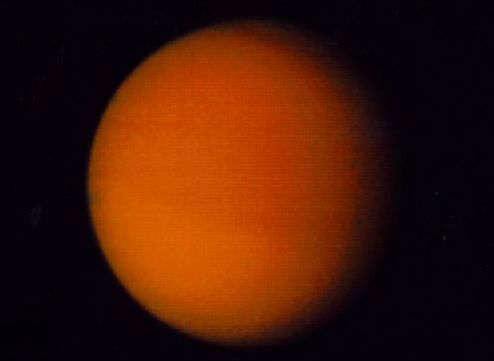
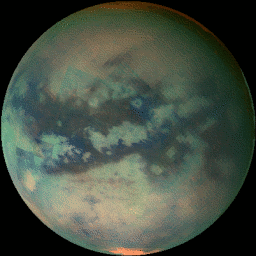
Titan from Voyager 2 Credit NASA
Titan from Cassini -credit VIMS Team, U. Arizona, ESA, NASA
Titan is the largest moon of Saturn and also the most unusual. It, like Ganymede, is larger than Mercury (or Pluto). Titan captured the imagination of early astronomers ever since they discovered that it had an atmosphere composed mostly of nitrogen (like our own atmosphere). Even stranger, spectral analysis shows that Titan's atmosphere is a "smog" of methane, ethane, and carbon dioxide. We had to go there!!!! On 2005, the Cassini craft released the Huygens probe, ... which landed on Titan in January 2005. It showed us ravines carved out by liquid hydrocarbons. Those dark patches in the image above are basically lakes of liquefied natural gas. It rains methane on Titan!
The Cassini probe made a pretty interesting discovery in 2005. As it flew past the small moon Enceladus, it observed ice geysers shooting from the moon's south pole region. This gives astronomers yet another place to wonder if a liquid ocean lies below the ice (which all the data points to). Could life exist there too?

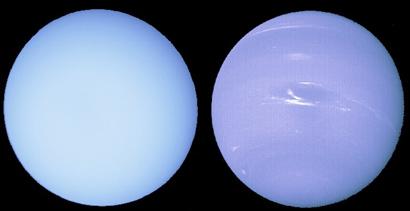
Uranus and Neptune Credit NASA
These two middleweight gas planets lie far from the sun. They are also mostly hydrogen and helium in composition but appear blue because of small amounts of atmospheric methane which absorbs most of the spectrum and reflects blue light. Uranus is unusual in that its axis is tilted 98 degree to the plane of the ecliptic, giving it the most extreme "seasons" of any planet. It basically spins on its side. Neptune is one of the windiest planets, with speeds up to 700 mph. This discovery was a big surprise since it was felt that atmospheric activity would be slower in deep cold space. Apparently, Neptune's atmosphere is driven by internal heat rather than heat from the sun.
Surface of Miranda Credit NASA (click on image to enlarge)
One of the moons of Uranus is quite usual. Miranda's surface looks like a random mixture of rock and ice. This suggests that this moon was recently re-assembled. That is, it may be that some moons form when ring material coalesces under the force of gravity. Does this mean that rings may be a temporary "phase" in the evolution of a planet? Astronomers caution that it can happen only if tidal forces (exerted by the planet) can be overcome. For example, the rings of Saturn will not form into a moon because the rings lie within the planet's "Roche limit". That is, they lie too close to Saturn ... so close that tidal forces will disrupt any attempt to assemble them into a larger body. It still may be that the rings of Saturn are a temporary feature, but they will not become a moon.
Another interesting moon that orbits Neptune is Triton. What makes this moon interesting is the way it orbits Neptune, which is retrograde to the direction of Neptune's rotation. How can that happen? Perhaps it formed in the Kuiper belt and was captured by Neptune's gravity????
The demoted planet, Pluto, keeps losing prestige.
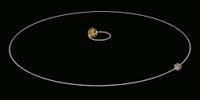
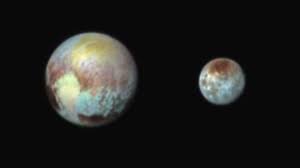
The New Horizons spacecraft reached Pluto in July 2015. It might be interesting to know that the largest moon of Pluto - Charon, is large enough to consider the system a "double object" Not only was Pluto demoted to a dwarf planet, it now has to share the stage with a partner. As of 2014, there are 5 known satellites associated with Pluto.
 Charon ...
Pluto's little brother.
Charon ...
Pluto's little brother.
Charon has drawn most of the attention since its icy surface shows evidence of tectonics. These "stretch marks" likely formed from an earlier time when liquid water once existed below the surface then eventually froze and expanded.
Both Pluto and Charon show spotty reddish areas. The best guess is that the red areas are from a chemical called tholin. When compounds, like methane, are exposed to ultraviolet radiation, they turn red. There have been other guesses for these features on both Pluto and Charon so the matter has not been settled.
Making a solar system ... or just when you thought you understood it ... something happens
Astronomers believed that they knew how our solar system was formed and why it has the overall properties we find in our solar system today. Our sun, they believed, formed from a great cloud of gas, known as the solar nebula. As the gasses within the nebula condensed and contracted, they eventually formed the sun. However, a small amount of material was left behind which formed a disk of debris (known as an accretion disk). This orbiting material would become the raw material for making the planets. This part of the story is even backed up by photographs of other stellar systems.

Credit C. Burrows and J. Krist (STScI), WFPC2
IDT Team, NASA, ESA
We now know that many young stars have a flat accretion disk of debris surrounding them. This could be solar systems in the making. Astronomers believed that solid planetesimals quickly collect together to make the planets. The inner planets are small and dense because it is far too hot for icy (lower density) planetesimals to form in that region. Farther from the sun (where it is much colder), planetesimals of rock and ice are able to form. This means the Jovian planets are able to grow much bigger and more massive. Eventually, they acquire so much mass that they are able to gravitationally attract the much lighter gasses such as hydrogen and helium. Bingo ... you just made a giant gas world. The problem is ... astronomers have since discovered many star systems with planets ... but they don't look anything like our solar system. These systems show giant gassy planets which orbit very close to their parent star. It is like finding a "super Jupiter" lying inside the orbit of Mercury .... hence the name "hot Jupiters". Astronomers didn't think this was possible, so the model needs revision. Is it possible that these planets formed in a more distant sector of their solar system and then migrated closer to the parent star? Another question is ... is our solar system "typical" or a planetary "freak"? It is too early to answer these questions.
Things got fuzzier with the discovery of rogue planets. These are planets drifting in space and not associated with any parent star. The origin of these orphans is puzzling. Did they form around a star and get ejected? Did they form in open space all by themselves? How many rogue planets are there? Could one of these planets get "captured" by an approaching star? More questions than answers!
The list of exoplanets keeps growing (over 5,500 in 2023). The hunt to find "Earth's twin" is under way.. The goal of the Kepler observatory (and Transiting Exoplanet Survey Satellite or TESS, launched in 2018) may succeed in finding another world like our home planet. Several close matches have been confirmed. This question is a topic for a class research topic so I will resist posting any results.
When our planetary brother is found, will it orbit in the "habitable zone" (making liquid water possible)? Will we discover life ... intelligent life? This is a very exciting time in astronomy!
ŠJim Mihal 2004, 2014, 2017, 2020, 2023 - all rights reserved